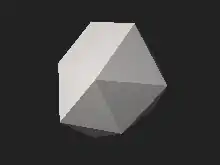Disphenocingulum
In geometry, the disphenocingulum or pentakis elongated gyrobifastigium is one of the Johnson solids (J90). It is one of the elementary Johnson solids that do not arise from "cut and paste" manipulations of the Platonic and Archimedean solids.
| Disphenocingulum | |
|---|---|
 | |
| Type | Johnson J89 - J90 - J91 |
| Faces | 4+2x8 triangles 4 squares |
| Edges | 38 |
| Vertices | 16 |
| Vertex configuration | 4(32.42) 4(35) 8(34.4) |
| Symmetry group | D2d |
| Dual polyhedron | Order-5 truncated snub disphenoid |
| Properties | convex |
| Net | |
 | |

A Johnson solid is one of 92 strictly convex polyhedra that is composed of regular polygon faces but are not uniform polyhedra (that is, they are not Platonic solids, Archimedean solids, prisms, or antiprisms). They were named by Norman Johnson, who first listed these polyhedra in 1966.[1]
Cartesian Coordinates
Let a ≈ 0.76713 be the second smallest positive root of the polynomial
and and .
Then, Cartesian coordinates of a disphenocingulum with edge length 2 are given by the union of the orbits of the points
under the action of the group generated by reflections about the xz-plane and the yz-plane.[2]
References
- Johnson, Norman W. (1966), "Convex polyhedra with regular faces", Canadian Journal of Mathematics, 18: 169–200, doi:10.4153/cjm-1966-021-8, MR 0185507, Zbl 0132.14603.
- Timofeenko, A. V. (2009-10-17). "The non-platonic and non-Archimedean noncomposite polyhedra". Journal of Mathematical Sciences. 162 (5): 710–729. doi:10.1007/s10958-009-9655-0. ISSN 1072-3374. S2CID 120114341.